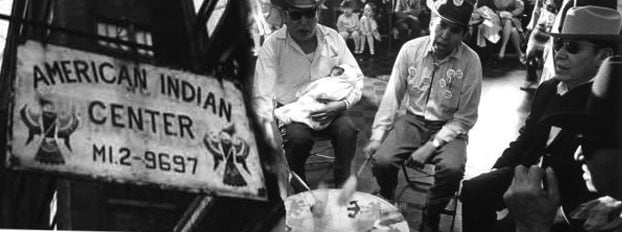
Chicago's Urban Indians
In the 1950s, the federal government
came up with a plan to move Indians off the reservations and to the urban
centers, including Chicago. This scheme was called, simply, Relocation. "Chicago's
Urban Indians" looks at the resulting effects, both positive and negative,
on our city's approximately 30,000 Native Americans today.
Economic opportunities for most Indians were limited. Some reservations
were little more than shacks, without electricity or running water.
In more desolate areas, unemployment typically ran from 50-80%,
and the average life span for both male and female Indians was
barely 44 years.
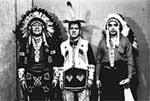 In the late 1940s, the Federal Bureau of Indian Affairs initiated its Relocation
plan to encourage Indians to move to the cities, where there were jobs. Professor
Don Fixico of the University of Kansas recalls, "Relocation was an experimental
program -- for it to work, there had to be a certain number of individuals 'volunteering' for
relocation. Most American Indians didn't know what it was."
In the late 1940s, the Federal Bureau of Indian Affairs initiated its Relocation
plan to encourage Indians to move to the cities, where there were jobs. Professor
Don Fixico of the University of Kansas recalls, "Relocation was an experimental
program -- for it to work, there had to be a certain number of individuals 'volunteering' for
relocation. Most American Indians didn't know what it was."
The
chief architect of Relocation was a lifelong bureaucrat named Dillon
S. Myer, whose primary qualification for the job was a dubious
one: he had been a senior official in the program that moved Japanese-Americans
into internment camps during World War II. While Myer did not consider
the Indians to be national security risks, unlike the Japanese, his
goal was to have the Indians assimilate into the mainstream of
American life. In doing so, he felt Indians would have more opportunity
to improve their circumstances but also lose their identity as
a people that require so much financial support from the government.
In reality, however, most of the Indians who moved from the reservations
to the city exchanged one form of poverty for another -- the city
environment and resulting
culture shock proved daunting to many. "They were trained to be housekeepers
and cooks. They were taught trades," says Pat Tyson of St. Augustine's Center
for American Indians. "They weren't taught to be professional people." A significant
number couldn't afford decent food or housing, and soon found themselves on public
aid once their government Relocation support ran out. The Indians placed much
of the blame on the Bureau of Indian Affairs, which, they claimed, betrayed them
by promising a better life if they left the reservations, then abandoning them
once they came to Chicago.
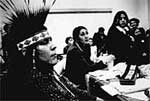 It became apparent to these new "Urban Indians" they would have
to rely less on the U.S. government and more on each other if the
community was to survive.
In 1954, members of the various tribes formed two support organizations: the
All-Tribes American Indian Center and St. Augustine's Center for American Indians,
both of which are still going strong today. In the 1960s, Indian groups organized
protests against government policies that eventually helped bring an end to Relocation.
In addition, the Indians created their own homeland in neighborhoods like Hyde
Park and Uptown that brought more cohesion to the Chicago Indian community at
large, one that encompasses as many as 100 tribes. Fixico explains, "Indian people
have been re-tribalized -- a key to Indian life is community values."
It became apparent to these new "Urban Indians" they would have
to rely less on the U.S. government and more on each other if the
community was to survive.
In 1954, members of the various tribes formed two support organizations: the
All-Tribes American Indian Center and St. Augustine's Center for American Indians,
both of which are still going strong today. In the 1960s, Indian groups organized
protests against government policies that eventually helped bring an end to Relocation.
In addition, the Indians created their own homeland in neighborhoods like Hyde
Park and Uptown that brought more cohesion to the Chicago Indian community at
large, one that encompasses as many as 100 tribes. Fixico explains, "Indian people
have been re-tribalized -- a key to Indian life is community values."
Today, Chicago's "Urban Indians" continue to struggle to maintain their identity.
They look to their children to combine the best of both environments, the traditional
values of the reservation and the modern culture of the city.
Urban
Indians
Recollections
by Peggy Desjartait
Here are highlights of what Peggy Desjartait, who relocated to Chicago from North
Dakota, told the producers of "Chicago's Urban Indians."
Observations
by Professor Don Fixico
More about Relocation and its impact by Professor Don Fixico of the University
of Kansas.
Links of Interest
Department
of the Interior Bureau of Indian Affairs
The BIA administers federal services and programs for recognized Indian tribes,
and promotes Indian self-determination.
American Indian
Heritage Foundation
The American Indian Heritage Foundation has served the emergency relief needs
of native peoples of this land for the past 28 years.
National Museum
of the American Indian
The museum helps foster, protect and promote understanding of Native American
cultures by collaborating with indigenous peoples across the Western Hemisphere.
NATIVECULTURE.COM
This is a comprehensive portal site for Native American resources on the Internet.
The Mitchell Indian Museum of Kendall College
2600 Central Park
Evanston, IL 60201
847 / 475-1030
Permanent exhibits of Native American Art, 5000 b.c. to the present.
November
is National American Indian Heritage Month
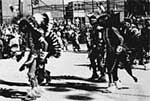 Although the first "American Indian Day" was declared by the State of New York
in 1916, a month-long recognition of Native Americans was not achieved until
1990. In that year, President George Bush declared the first National American
Indian Heritage Month. In each of the four previous years, Congress had enacted
legislation designating "American Indian Heritage Week." This consecutive legislation
allowed for the establishment of a month-long observance. The purpose of National
American Indian Heritage Month http://www.ihs.gov/PublicInfo/heritage/index.asp
is to honor and recognize the original peoples of this land. The theme for 2001
is "Our Children, Our Nations, Our Future."
Although the first "American Indian Day" was declared by the State of New York
in 1916, a month-long recognition of Native Americans was not achieved until
1990. In that year, President George Bush declared the first National American
Indian Heritage Month. In each of the four previous years, Congress had enacted
legislation designating "American Indian Heritage Week." This consecutive legislation
allowed for the establishment of a month-long observance. The purpose of National
American Indian Heritage Month http://www.ihs.gov/PublicInfo/heritage/index.asp
is to honor and recognize the original peoples of this land. The theme for 2001
is "Our Children, Our Nations, Our Future."
Behind
the Scenes
by program producer Tracy Ullman
Shooting for "Chicago's Urban Indians" began on September 12th, the day after
the terrorist attacks in New York City and Washington, D.C. I felt lucky that
we were just shooting artifacts that day, not asking people to go in front of
our cameras. We visited such locations as the site of the art deco Indian statues
on Congress and Michigan, the ornate interior of the Marquette Building and the
Kraft Totem Pole just east of Lake Shore Drive on Addison. Each embodied the
reverent, although somewhat misinformed, history of Indians in Chicago. The fine
mosaics in the Marquette Building showed the proud interactions of Indians with
explorer Joliet, while the loin-clothed Indians on horseback at Congress and
Michigan showed the "super-human" side of Indians--bareback and bare-chested,
even in Chicago's worst winters!
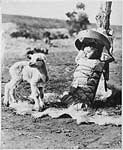 From there on, cameraman Carlton Hathcoat and I proceeded to meet
with people who came to Chicago through Relocation, during the
50s through the 70s, from all around the nation. Each of their
experiences had been different. Interviewee Peggy Desjarlait, originally
from New Town, North Dakota, had lost her husband to a knife fight
shortly after arriving in Chicago and suffered from the racist
attitudes of her employers. Alternatively, Edgar Ortiz relocated
from the Southwest and benefited from the support, both financial
and educational, of the Bureau of Indian Affairs who sponsored
Relocation.
From there on, cameraman Carlton Hathcoat and I proceeded to meet
with people who came to Chicago through Relocation, during the
50s through the 70s, from all around the nation. Each of their
experiences had been different. Interviewee Peggy Desjarlait, originally
from New Town, North Dakota, had lost her husband to a knife fight
shortly after arriving in Chicago and suffered from the racist
attitudes of her employers. Alternatively, Edgar Ortiz relocated
from the Southwest and benefited from the support, both financial
and educational, of the Bureau of Indian Affairs who sponsored
Relocation.
Both Carlton and I were shocked to know that there are more than 30,000 Indians
in the Chicago area, not including people who have one parent of non-Indian lineage.
We met many folk during a Pow Wow at the American Indian Center where there was
much talk about the September 11th attack. Although the Indians have had an incomparably
tough time between broken government promises and complicated red-tape, they
were resolute in supporting the United States through its battle with terror.
Tracy Ullman, producer of "Chicago's Urban Indians," also produced "The
Union Stockyards" for Chicago Stories. She began working on documentaries
at the BBC. Her previous docs have been on an eclectic variety of
subjects, including British politics, Greek Rush in the United States,
and dating over the age of 50.

Your $40 Gift Membership will include:
|
























































